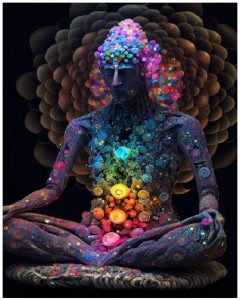BREAKING FREE FROM THE CHAINS OF THE EGO: UNDERSTANDING AND TRANSMUTING SADNESS, ANGER, AND FEAR

We all experience them – the unwelcome trio of sadness, anger, and fear. These emotions can feel like unwelcome guests, crashing into our lives and disrupting our carefully curated sense of peace. But what if instead of seeing them as enemies, we viewed them as messengers? Messengers carrying clues to the deepest workings of our minds and offering a path to freedom from the limitations of the ego.
This exploration delves into the heart of these three emotions, uncovering their connection to the core beliefs of the ego – lack, desire, and control – and offering practical tools to transmute their energy into pathways of personal growth and liberation.
The Roots of Suffering: The Three Core Beliefs of the Ego
Our journey begins with understanding the fertile ground in which these emotions flourish. The ego, with its cunning ways, thrives on three fundamental beliefs:
Belief in Lack: This primal feeling of incompleteness drives us to seek fulfillment outside ourselves, fueling the incessant search for love, happiness, and security in the external world. This belief whispers, “You are not enough,” leading to sadness and despair when our grasping hands find only emptiness.
Belief in External Fulfillment: Convinced that happiness lies beyond us, we chase after desires, clinging to the illusion that possessing the perfect relationship, job, or object will finally quench our thirst. This belief fuels anger when obstacles block our pursuit, turning frustration into rage.
Belief in Personal Control: Driven by the delusion of separateness, we strive to control our experiences, clinging to the reins of life as if we were the sole authors of our destinies.
This belief breeds fear – fear of the unknown, fear of loss, fear of failure. The tighter we grip, the more anxious and insecure we become.
The Emotional Compass: Identifying the Source of Your Discomfort
Now, let’s turn our attention to the emotional landscape. Sadness, anger, and fear act as beacons, illuminating the specific belief that is operating in the background. Here’s how:

Sadness: This melancholic hue points to the belief in lack. When you feel the sting of sadness, ask yourself, “What am I feeling I lack right now?” Is it love, appreciation, acceptance? Recognizing the underlying belief allows you to shift your focus from seeking fulfillment outside to the abundance that already lies within.
Anger: This fiery emotion erupts when the belief in external fulfillment collides with an obstacle. When anger flares, inquire, “What desire is being blocked? What outcome am I clinging to so tightly?” This awareness empowers you to detach from the fleeting pleasures of the external and seek lasting fulfillment within.
Fear: This chilling sensation arises from the belief in personal control. When fear grips you, ask yourself, “What am I trying to control? What am I clinging to that feels precarious?” Recognizing this need for control allows you to surrender to the flow of life, trusting that you are being held by a force far greater than yourself.
The Art of Transmutation: Tools for Transforming Suffering into Growth
Once we identify the source of our discomfort, the real work begins. The key lies in transmuting these emotions, not suppressing them. Here are some powerful tools to guide you on this journey:
For Sadness:
Practice Gratitude: Shift your focus from what you lack to the abundance already present in your life. Cultivate a daily gratitude practice, acknowledging the simple joys that often go unnoticed.
Give Generously: Share your love, time, and resources with others. In giving, you tap into the infinite wellspring of love within, simultaneously dispelling the illusion of lack.
Connect with Nature: Immerse yourself in the beauty and vastness of nature. Reconnect with the source of all life and feel your own inherent completeness.

For Anger:
Forgive Yourself and Others: Holding onto anger is like drinking poison and expecting the other person to die. Release the grip of resentment and choose forgiveness, not for them, but for your own inner peace.
Identify Your True Needs: Often, anger masks deeper unmet needs. Ask yourself, “What do I truly need in this situation? Is it validation, understanding, or simply to be heard?” Addressing the underlying need can dissolve the anger.
Express Yourself Creatively: Channel the energy of anger into a creative outlet, such as painting, writing, or dance. This allows you to release the emotional charge in a healthy and transformative way.
For Fear:
Practice Surrender: Release the illusion of control and surrender to the flow of life. Trust that you are being guided by a greater intelligence, even when the path seems uncertain.
Focus on the Present Moment: Fear thrives on ruminating about the future or regretting
Breaking Free From the Chains of the Ego: Understanding and Transmuting Sadness, Anger, and Fear
Focus on the Present Moment: Fear thrives on ruminating about the future or regretting the past. Practice mindfulness to anchor yourself in the present moment, where there is only Now and the inherent peace that resides within.
Connect with Your Higher Power: Whether you call it the universe, God, or your inner wisdom, connect with something greater than yourself. This connection reminds you of your inherent safety and belonging, dispelling the feeling of isolation that fuels fear.
Remember, the journey of transmutation is not about becoming emotionless robots. It’s about acknowledging and embracing your emotions while understanding their source and choosing how you respond to them.
Beyond the Tools: Embracing a Shift in Perspective
The true liberation lies not just in mastering these tools, but in cultivating a fundamental shift in perspective. Here are some key realizations that can illuminate your path:

The Ego is Not You: Recognize that the ego, with its limiting beliefs, is not your true self. You are the vast awareness that observes the ego’s antics without judgment. This detachment empowers you to choose how you engage with your emotions, rather than being ruled by them.
You Are Already Whole: Release the belief in lack and embrace your inherent completeness. You are not broken, missing, or deficient. You are a radiant being already brimming with love, joy, and peace.
Life is a Journey, Not a Destination: Let go of the need to control and surrender to the unfolding mystery of life. Trust that each experience, even the challenging ones, are opportunities for growth and expansion.
By integrating these realizations into your daily life, you begin to see through the illusions of the ego and experience the world from a place of inner peace and freedom. The three emotions that once felt like unwelcome guests become valuable teachers, guiding you towards greater self-awareness and a life overflowing with joy, love, and purpose.
This is just the beginning of your journey. As you explore these concepts further, you will discover countless other tools and practices that resonate with your unique path. Remember, the key is to remain open to learning, to experiment with what works for you, and to trust the innate wisdom that resides within.
May your journey towards inner liberation be filled with light, love, and unwavering faith in your own infinite potential. I have developed a WORKBOOK to help break free from the chains of ego which can help you transmute your emotions.
WORKBOOK
Breaking Free from the Chains of the Ego
Welcome to your journey of emotional transmutation! This workbook will guide you in exploring the root of sadness, anger, and fear, uncovering the limiting beliefs of the ego that fuel them, and equipping you with powerful tools to transform these emotions into catalysts for growth and liberation.
Part 1: Identifying the Source of Your Discomfort
Exercise 1: Mapping Your Emotions
For one week, track your emotions in a journal. Note the time, situation, and specific feelings you experience. Identify when sadness, anger, or fear arise most prominently.
Journaling Prompt: What patterns do you notice in your emotional landscape? Are there particular triggers or themes that seem to be associated with each emotion?
Exercise 2: The Belief Detective
➢ Choose a recent instance of sadness, anger, or fear. In your journal, answer these questions:
➢ What was the specific event or situation that triggered this emotion?
➢ What thoughts or beliefs were running through your mind at the time?
➢ Can you connect these thoughts to any of the three core ego beliefs (lack, external fulfillment, control)?
Journaling Prompt: How did identifying the underlying belief impact your understanding of the emotion? Did it offer any insights into potential pathways for transmutation?
Part 2: Tools for Transmutation
Exercise 3: Cultivating Gratitude
➢ For the next three days, practice gratitude in several ways:
➢ Keep a gratitude journal, listing at least three things you’re grateful for each day.
➢ Express gratitude verbally to people in your life.
➢ Savor small moments of joy and beauty in your everyday experience.
Journaling Prompt: How did your gratitude practice affect your overall mood and emotional well-being? Did you notice any shifts in your experience of sadness or lack?
Exercise 4: Channeling the Fire of Anger
➢ Choose a past situation where you experienced anger. In your journal:
➢ Write a letter to the person or situation that triggered your anger, pouring out your emotions without holding back.
➢ After releasing the raw energy, rewrite the letter from a place of understanding and forgiveness.
➢ Alternatively, express your anger creatively through art, music, or physical activity.
Journaling Prompt: Did expressing your anger in a safe space help to release its grip on you? How did it differ from simply suppressing or acting out on your anger?
Exercise 5: Embracing Surrender
➢ Identify an area of your life where you feel the need to control. In your journal:
➢ Acknowledge the fear or anxiety associated with letting go of control in this area.
➢ Practice affirmations like “I trust the flow of life” or “I am safe and supported.”
➢ Take small steps towards releasing control, such as delegating tasks or accepting unexpected changes.
Journaling Prompt: How did your willingness to surrender affect your level of fear and anxiety? Did you experience any unexpected benefits of letting go?
Part 3: Embracing a New Perspective
Exercise 6: Observing the Ego
For one day, become an observer of your own thoughts and behaviors. Notice any instances where the ego’s voice is playing through your mind, pushing you towards fear, desire, or lack.
Journaling Prompt: What did you learn about the ego’s tactics? How did recognizing its presence empower you to choose a different response?
Exercise 7: Reclaiming Your Wholeness
➢ Think of a time when you felt truly complete and fulfilled, independent of external circumstances. In your journal:
➢ Reconnect with the memory of that feeling. Describe the sensations, emotions, and thoughts associated with it.
➢ Remind yourself that this state of wholeness is your natural state of being, not something you need to attain.
Journaling Prompt: How can you incorporate practices or reminders into your daily life to access that feeling of wholeness more often?
Remember, this workbook is a tool to guide your exploration. Be patient with yourself, experiment with different practices, and trust your inner wisdom to lead you on your unique path to emotional freedom and liberation.
 Dr K. Jayanth Murali is a retired IPS officer and a Life Coach. He is the author of four books, including the best-selling 42 Mondays. He is passionate about painting, farming, and long-distance running. He has run several marathons and has two entries in the Asian book of Records in full and half marathon categories. He lives with his family in Chennai, India. When he is not running, he is either writing or chilling with a book.
Dr K. Jayanth Murali is a retired IPS officer and a Life Coach. He is the author of four books, including the best-selling 42 Mondays. He is passionate about painting, farming, and long-distance running. He has run several marathons and has two entries in the Asian book of Records in full and half marathon categories. He lives with his family in Chennai, India. When he is not running, he is either writing or chilling with a book.
